How to Cook Chicken Livers for Dogs: 7 Healthy Recipes
Learning how to cook chicken livers for dogs can transform your pet’s diet with powerful nutrition. Chicken liver for dogs provides essential vitamins, minerals, and high-quality protein that support overall health and vitality. This comprehensive guide covers everything from selection to preparation, helping you master safely cooking these nutrient-packed organ meats for your canine companion.
Table of Contents
The Nutritional Benefits of Chicken Livers for Dogs
Before diving into how to cook chicken livers for dogs, it’s important to understand why they’re such a valuable addition to your pet’s diet. Chicken liver for dogs offers an impressive array of nutrients in a compact, flavorful package.
Key Nutritional Components:
- Vitamin A: Essential for vision, immunological response, and cell growth
- B Vitamins: Particularly B12, which supports neurological function
- Iron: Essential for oxygen transport and healthy blood cells
- Protein: High-quality, easily digestible protein for muscle maintenance
- Folate: Important for cell division and tissue growth
- Minerals: Including copper, zinc, and phosphorus
When you learn how to cook liver for dogs correctly, you preserve these nutrients while making them safe and digestible for your pet. This makes chicken livers an excellent supplement to other chicken recipes for dogs in your homemade meal rotation.
Selecting the Best Chicken Livers for Dogs
The first step in learning how to cook chicken livers for dogs is selecting quality ingredients. Freshness and quality are crucial when selecting chicken liver for dogs:
Quality Indicators:
- Color and Appearance: Fresh chicken livers should be glossy and have a deep reddish-brown color.
- Smell: Mild odor; avoid livers with a strong or unpleasant smell
- Texture: Smooth and firm, not mushy or sticky
- Source: When possible, choose organic or free-range options
Unless you intend to freeze them, only buy enough chicken livers for dogs that you will consume in the next one to two days. Store fresh livers in the coldest part of your refrigerator until you’re ready to cook them.
Essential Tools for Cooking Chicken Livers for Dogs
Before learning how to cook chicken livers for dogs, gather these kitchen tools:
- Digital meat thermometer: Ensures chicken livers reach a safe internal temperature of 165°F
- Sharp knife: For trimming and cutting the liver into appropriate portions
- Cutting board: Dedicated to raw meat preparation
- Medium saucepan: For boiling or poaching methods
- Baking sheet: For oven methods
- Storage containers: For refrigerating or freezing cooked liver
- Measuring cups and spoons: For accurate portions
You can safely and effectively prepare chicken livers for your dog if you have these tools on hand.
How to Cook Chicken Livers for Dogs: 7 Effective Methods
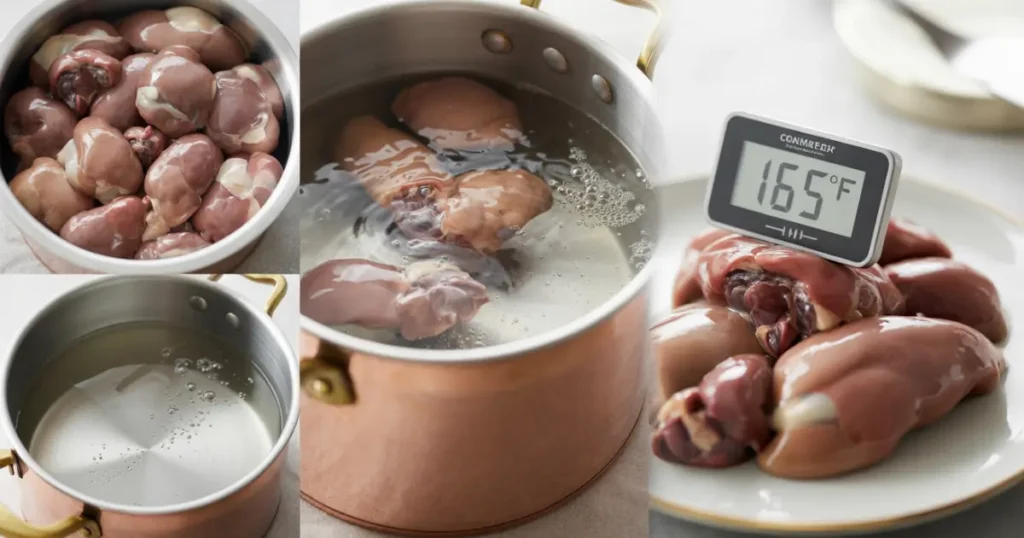
Before trying these specific organ meat preparations, you may want to learn the basics of properly cooking chicken for dogs to ensure you’re handling all poultry safely.
1. Basic Boiling Method
Difficulty Level: Beginner
Best For: Most dogs, first-time liver introduction
Ingredients:
- 1 pound chicken livers
- 4 cups water
Instructions:
- Rinse chicken livers thoroughly under cold water
- Remove any connective tissue or discolored areas
- Place in a medium saucepan and cover completely with water
- Bring to a gentle boil over medium heat
- Lower the heat to a simmer and cook for ten to fifteen minutes, or until the internal temperature reaches 165°F.
- Drain and cool completely before serving
Benefits of Boiling:
- Simple method requiring minimal monitoring
- Creates a mild flavor profile that most dogs enjoy
- Retains nutrients while ensuring food safety
2. Gentle Poaching Technique
Difficulty Level: Beginner
Best For: Maximizing tenderness
Ingredients:
- 1 pound chicken livers
- 4 cups water or low-sodium chicken broth (no onions or garlic)
Instructions:
- Clean and trim chicken livers as described above
- Bring the liquid to just below boiling (small bubbles will form around the pan’s edge).
- Add chicken livers carefully
- Maintain the liquid at a gentle simmer—not boiling—for 8-10 minutes
- Verify internal temperature reaches 165°F
- Remove from liquid, cool completely, and portion appropriately
Benefits of Poaching:
- Produces an extremely tender texture ideal for senior dogs
- Gentle cooking preserves more nutrients
- Works well for dogs with dental issues
3. Baking for Convenience
Difficulty Level: Beginner
Best For: Batch preparation, creating a firmer texture
Ingredients:
- 1 pound chicken livers
- Optional: 1 teaspoon olive oil
Instructions:
- Preheat oven to 350°F
- Rinse and trim chicken livers
- Line a baking sheet with parchment paper
- Liver pieces should be arranged in a single layer with space between them.
- Lightly brush with olive oil if desired (helps prevent drying)
- Bake for 15 to 20 minutes, or until the internal temperature reaches 165°F.
- Allow to cool completely before serving
Benefits of Baking:
- Hands-off cooking approach
- Can prepare larger batches at once
- gives some dogs a preferred texture that is firmer and less moist.
4. Steaming for Maximum Nutrition
Difficulty Level: Intermediate
Best For: Preserving nutritional content
Ingredients:
- 1 pound chicken livers
- Water for the steamer
Instructions:
- Set up a steamer basket over a pot with 1-2 inches of water
- Bring water to a simmer
- Put the chicken livers in the steamer basket after cleaning and trimming them.
- Cover and steam for 10-12 minutes
- Check that the internal temperature reaches 165°F
- Cool completely before serving
Benefits of Steaming:
- Locks in nutrients with minimal loss
- Clean cooking method with no direct water contact
- Maintains moisture while thoroughly cooking the livers
5. Sautéing for Enhanced Flavor
Difficulty Level: Intermediate
Best For: Special treats, high-value training rewards
Ingredients:
- 1 pound chicken livers
- 1 tablespoon olive oil or coconut oil
Instructions:
- Pat the livers dry after rinsing and trimming
- Heat oil in a skillet over medium heat
- Place the livers in the pan without overcrowding
- Cook for 2-3 minutes per side until browned and firm
- Ensure internal temperature reaches 165°F
- Drain on paper towels and cool completely
- Slice into portions of the right size for snacks or meals.
Benefits of Sautéing:
- Creates enhanced flavor that dogs typically love
- Makes excellent high-value training treats
- Different texture adds variety to your dog’s diet
6. Pressure Cooking for Speed and Convenience
Difficulty Level: Intermediate
Best For: Quick preparation, busy pet parents
Ingredients:
- 1 pound chicken livers
- 1 cup water
Instructions:
- Clean and trim chicken livers
- Place in a pressure cooker with water
- Seal according to the manufacturer’s instructions
- Cook on high pressure for 3 minutes
- After 5 minutes of letting the pressure drop naturally, quickly release it.
- Verify internal temperature reaches 165°F
- Drain and cool completely before serving
Benefits of Pressure Cooking:
- Fastest cooking method
- Retains nutrients efficiently
- Consistent results with minimal monitoring
7. Slow Cooking for Busy Pet Parents
Difficulty Level: Beginner
Best For: Hands-off preparation
Ingredients:
- 1 pound chicken livers
- 1 cup water or low-sodium broth
Instructions:
- Rinse and trim chicken livers
- Place in a slow cooker with liquid
- Cook for one hour on high or two hours on low.
- Check that the internal temperature reaches 165°F
- Drain and cool completely before serving
Benefits of Slow Cooking:
- Set-and-forget convenience
- Great for busy schedules
- Produces very tender results
Proper Serving Guidelines for Chicken Livers
After learning how to cook chicken livers for dogs, serving them properly is equally important. Chicken liver for dogs should be offered in appropriate portions based on your pet’s size:
Recommended Serving Sizes:
- Small dogs (under 20 lbs): 1/2 to 1 tablespoon, 1-2 times weekly
- Medium dogs (20-50 lbs): 1-2 tablespoons, 1-2 times weekly
- Large dogs (over 50 lbs): 2-3 tablespoons, 1-2 times weekly
Important Feeding Tips:
- Begin modestly: When introducing liver for the first time, start with small amounts.
- Gradual introduction: Monitor for any digestive upset for 24-48 hours
- The key is moderation: No more than 5–10% of your dog’s diet should consist of chicken livers.
- Consistency matters: Chop or mash according to your dog’s size and chewing ability
- Temperature: Serve at room temperature for best acceptance
When you understand how to cook liver for dogs properly, you can incorporate it into their diet in various ways:
- Mixed into regular meals as a nutrient boost
- When sliced into small pieces, they serve as valuable training treats.
- Combined with other ingredients for homemade meal toppers
- Incorporated into balanced homemade meals
Storing Cooked Chicken Livers for Dogs
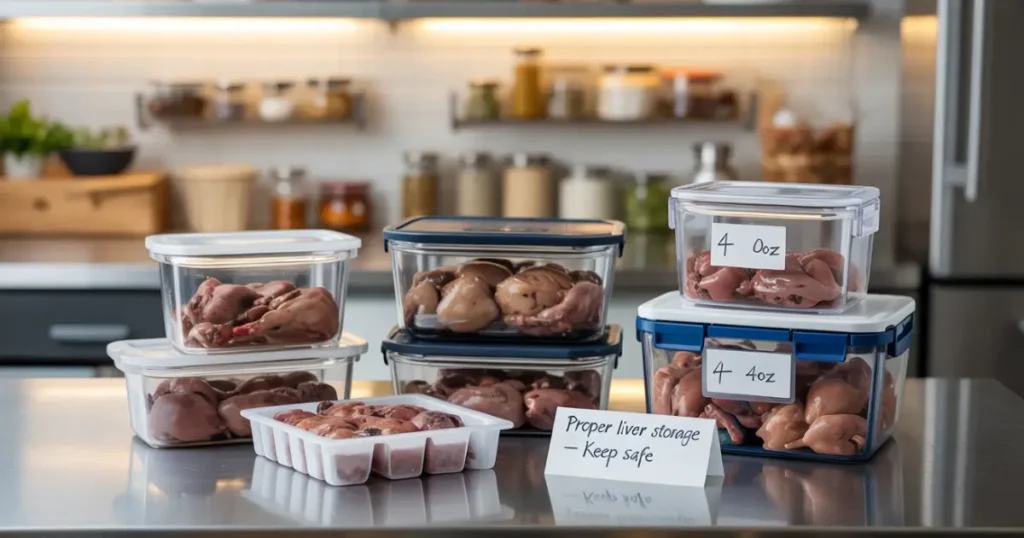
Your prepared chicken livers’ usability is increased by proper storage:
Refrigeration:
- Store in airtight containers for up to 3 days.
- Keep in the coldest part of your refrigerator (below 40°F)
- Divide into serving sizes before storing for easier use
Freezing:
- Portion into individual serving sizes
- Store in freezer-safe containers or ice cube trays
- Freeze for up to 3 months
- Label with contents and preparation date
Thawing Safely:
- Never thaw at room temperature; instead, do so overnight in the refrigerator.
- Use within 24 hours of thawing
- Never refreeze previously frozen cooked liver
Health Considerations When Feeding Chicken Livers
Understanding potential health implications is crucial when learning how to cook chicken livers for dogs. While chicken liver for dogs is highly nutritious, there are important factors to consider:
Important Health Considerations:
- Vitamin A toxicity: Hypervitaminosis A, or vitamin A toxicity, can result from consuming too much liver.
- Caloric content: Liver is calorie-dense and should be counted in daily caloric intake
- Digestive adjustment: Some dogs may need time to adapt to liver in their diet
Signs of Vitamin A Overconsumption:
- Joint stiffness or pain
- Digestive upset (vomiting or diarrhea)
- Lethargy or behavioral changes
- Weight loss
- Bone abnormalities (in severe cases)
When to Avoid Chicken Livers:
- Dogs with diagnosed liver disease (unless veterinarian approved)
- Pets with known chicken allergies
- Dogs on specialized prescription diets (unless veterinarian-approved)
Before making major dietary changes for your dog, especially if they already have health issues, always get advice from your veterinarian.
Balanced Recipes Incorporating Chicken Livers
Try these well-balanced recipes after you’ve perfected the art of cooking chicken livers for dogs:
Chicken Liver and Rice Bowl
This recipe works wonderfully as a complement to other chicken and rice recipes for dogs that form the foundation of many homemade dog food diets.
Ingredients:
- 1-2 tablespoons cooked chicken liver for dogs (chopped)
- 1/2 cup cooked brown rice
- 1/4 cup steamed vegetables (carrots, green beans)
- 1 teaspoon fish oil
Instructions:
- Combine all ingredients in your dog’s bowl
- Mix thoroughly and serve at room temperature
- Any leftovers can be kept in the fridge for up to two days.
Chicken Liver Training Treats
Ingredients:
- 1 pound cooked chicken livers
- 1 cup rolled oats
- 1 egg
Instructions:
- Puree cooked chicken livers in a food processor
- Combine with the egg and oats to create a thick dough.
- Spread thinly on a parchment-lined baking sheet
- Bake at 350°F for 15 minutes
- Cut into small pieces when cool
- Freeze for extended storage or refrigerate for up to five days.
For more complete meal ideas incorporating chicken livers properly, visit our guide to chicken recipes for dogs that contain properly balanced nutrition.
Key Takeaways
After learning how to cook chicken livers for dogs, keep in mind these crucial details:
- Prioritise safety: by cooking chicken livers until the internal temperature reaches 165°F.
- Quality Matters: Choose fresh, high-quality livers for maximum nutritional benefit
- Multiple Methods: Select from boiling, poaching, baking, steaming, sautéing, pressure cooking, or slow cooking based on your preference and time constraints
- Moderation is Key: Liver should comprise no more than 5-10% of your dog’s diet
- Proper Storage: Store cooked liver correctly to maintain safety and nutritional quality
- Health Awareness: Monitor your dog for any adverse reactions when introducing liver
- Veterinary Advice: Before making big dietary changes, speak with your veterinarian.
Conclusion
Learning how to cook chicken livers for dogs allows you to provide a nutrient-rich addition to your pet’s diet. By following proper selection, preparation, and serving guidelines, you can safely incorporate this nutritional powerhouse into your dog’s meals. Remember that moderation is key, and chicken liver for dogs should be just one component of a varied, balanced diet tailored to your dog’s specific needs.
For more comprehensive guides on preparing healthy homemade meals for your pet, explore our collection of nutritious chicken recipes for dogs that incorporate various ingredients, including organ meats, in properly balanced proportions.
Always consult with your veterinarian before making significant changes to your dog’s diet, especially if they have existing health conditions or dietary restrictions. With the right approach, chicken livers can be a beneficial and tasty addition to your dog’s nutritional regimen.
Following the principles of balanced canine nutrition ensures that additions like chicken liver enhance rather than unbalance your dog’s overall diet.
Frequently Asked Questions
How frequently can I give my dog chicken livers?
Dogs should only be fed chicken livers occasionally, usually no more than once or twice a week. Due to their high vitamin A content, excessive liver consumption can potentially lead to vitamin A toxicity over time. The precise frequency is determined by the size, general diet, and health of your dog.
Can puppies eat cooked chicken livers?
Yes, puppies can eat small amounts of properly cooked chicken livers. They’re especially beneficial during growth phases due to their concentrated nutrients. However, portions should be smaller than for adult dogs—approximately 1/4 to 1/2 teaspoon for small breed puppies. Always introduce new foods gradually to a puppy’s diet.
What if my dog doesn’t like chicken livers?
If your dog is hesitant about chicken livers, try different cooking methods. While some dogs might like the stronger flavor of sautéed liver, others might prefer the softer taste of boiled liver. Try mixing very small amounts into foods they already enjoy, gradually increasing the proportion. You can also try pureeing cooked liver and mixing it with other ingredients.
Are there alternatives to chicken livers for dogs?
If your dog cannot eat chicken livers or simply doesn’t enjoy them, other organ meats like beef liver, turkey liver, or hearts can provide similar nutrients. Each has a slightly different flavor and nutritional profile. Always introduce new organ meats gradually, following proper cooking guidelines for each type.


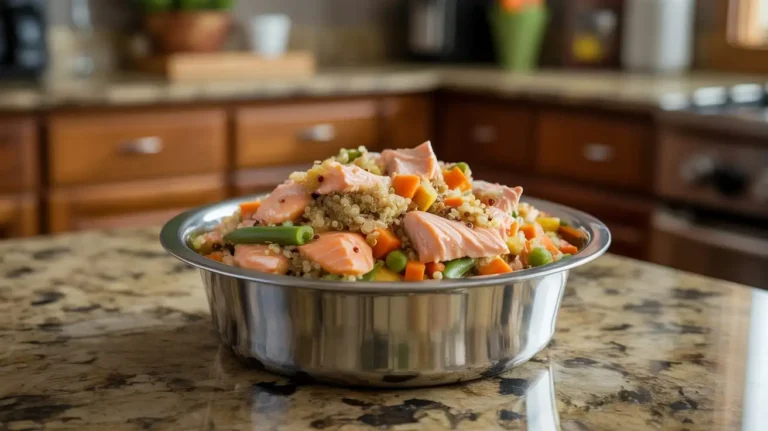
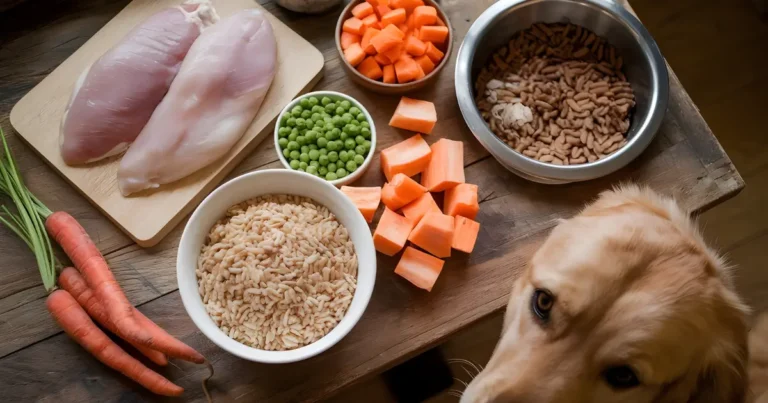
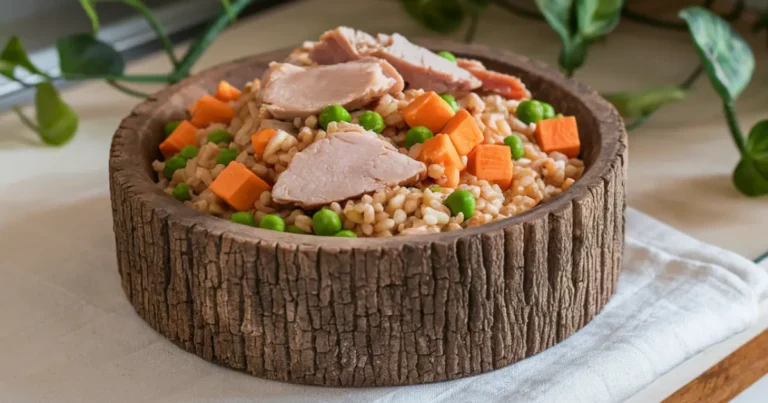
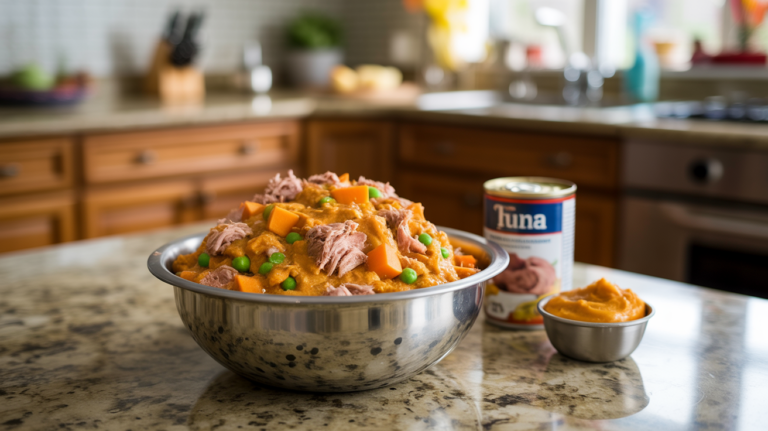
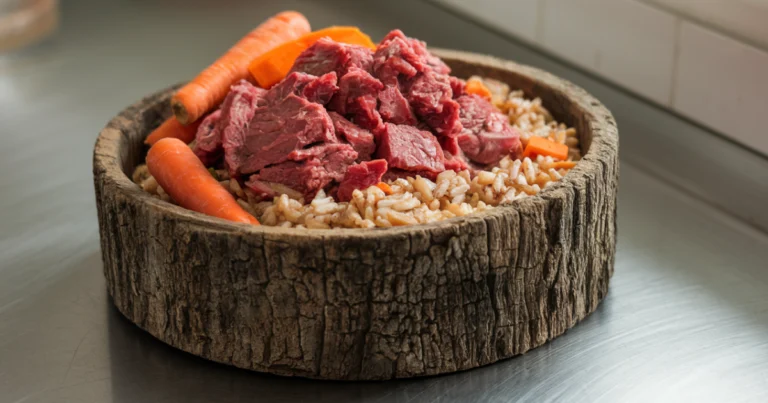
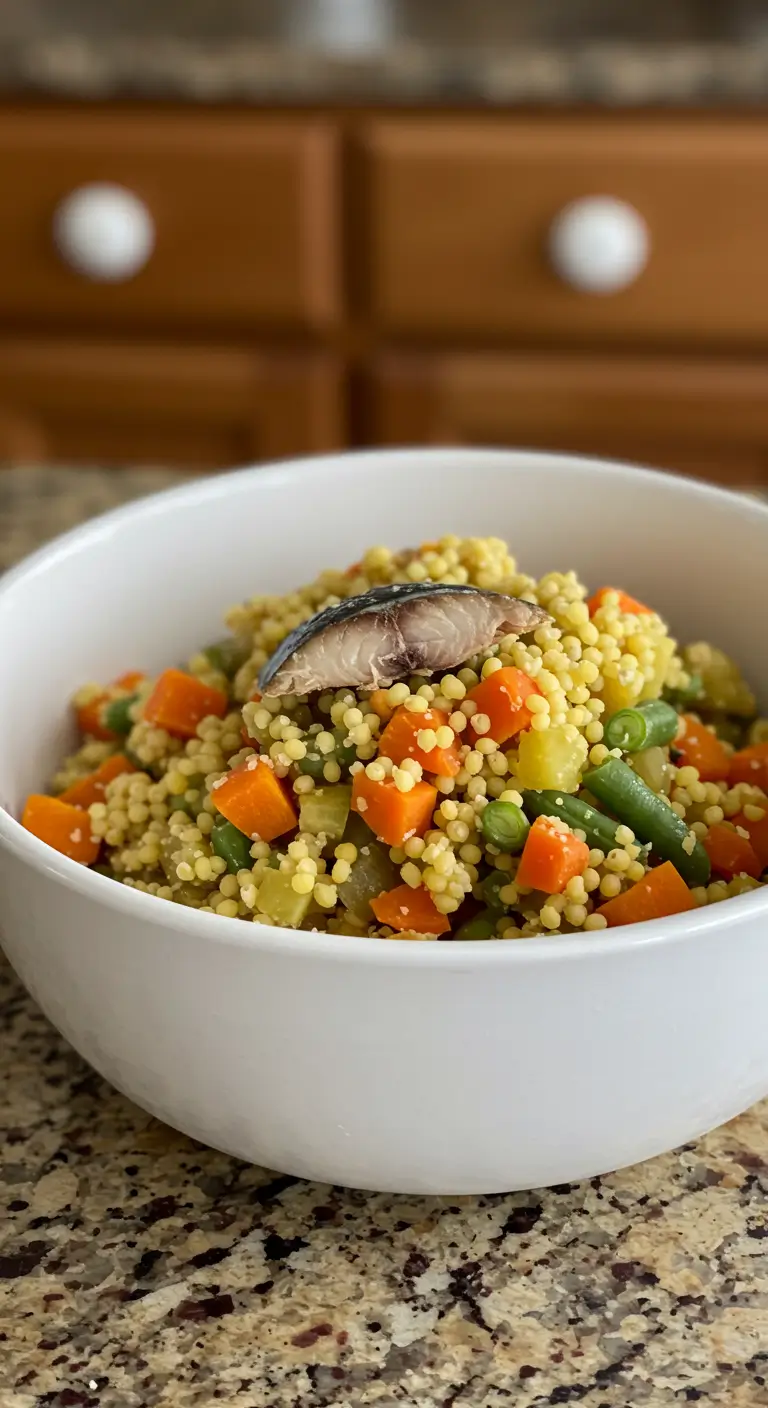
It’s in point of fact a great and useful piece of info.I am glad that you just shared this useful info with us.Please keep us informed like this. Thanks for sharing.